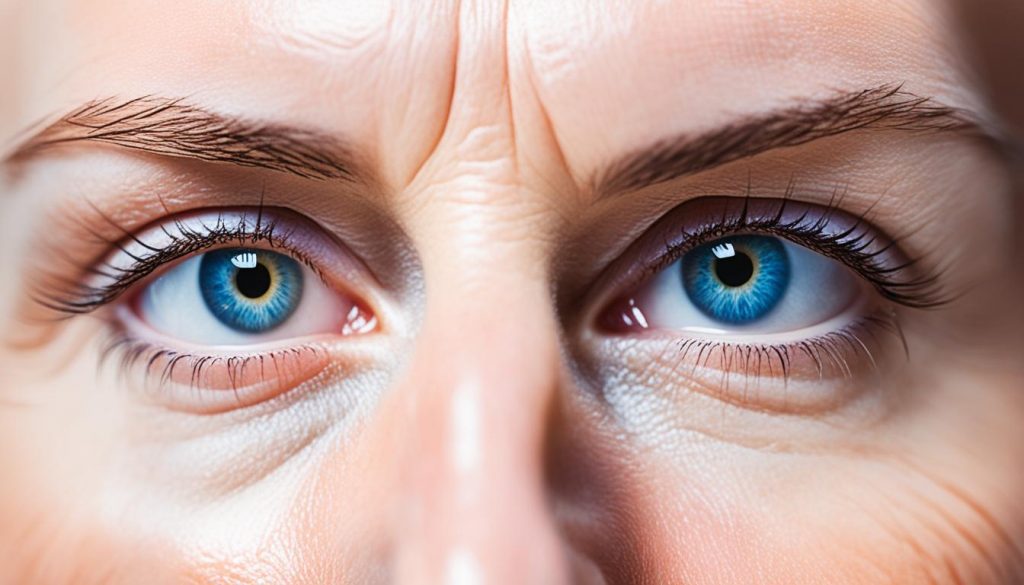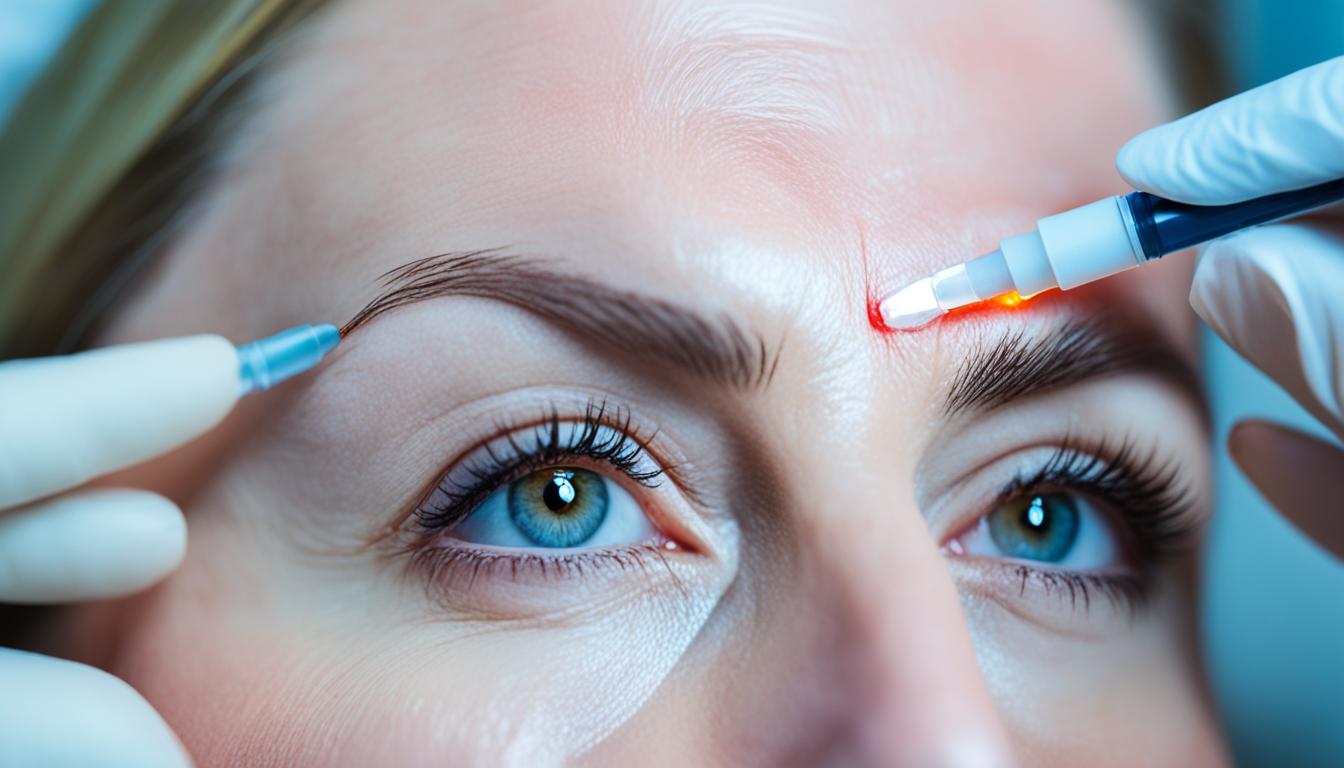Blepharitis is a common problem that makes your eyelids red, swollen, and irritated. This condition comes in two types. The first is anterior blepharitis, which affects the outside front part of your eyelids. The second type is posterior blepharitis, impacting the inner area closer to your eye.
Those suffering from this issue might notice their eyelids are red, puffy, and covered with crusty, flaky skin. Other unpleasant feelings include dry eyes, itching, and feeling like there’s sand in your eyes.
No one knows exactly why some people get blepharitis. It might come from bacteria or fungus, tiny eyelash bugs, or problems with eyelid oil glands. An eye doctor can figure it out with a detailed eye check.
To treat this eyelid problem, you can keep your eyelids clean, use warm cloths on your eyes, or get special medicine. For really tough cases, doctors might suggest trying stem cell therapy.
Key Takeaways:
- Blepharitis is an eyelid condition characterized by inflammation and irritation.
- It can be classified as anterior or posterior blepharitis.
- Symptoms of blepharitis include redness, swelling, crusty and flaky eyelids, dry eye, itching, and a gritty sensation.
- Possible causes of blepharitis include bacterial or fungal infections, eyelash mites, and dysfunction of the meibomian glands.
- Diagnosis is done through a comprehensive eye examination.
- Treatment options include eyelid hygiene, warm compresses, medications, and stem cell therapy in severe cases.
Understanding Blepharitis and Its Link to Dry Eye
Blepharitis is a common eyelid problem. It causes irritation and swelling. This condition is closely related to dry eye yet how they connect isn’t fully understood.
This issue impacts the meibomian glands crucial for eye moisture. When blepharitis strikes, it harms these glands. This leads to dry eye because the tear film gets messed up.
Inflammation and eyelid biofilm can block these important glands. This blockage stops oil from reaching the eye’s surface. Eyes then feel dry and uncomfortable.
Handling blepharitis well is key to lessening dry eye problems. Good eyelid care helps. This means cleaning the lids gently and using warm compresses. Sometimes, doctors may suggest medicines like eye drops to help.
In hard cases, new treatments like stem cell therapy are looked at. This therapy could fix the glands’ functions. It helps produce more tears to ease dry eye.
Dealing with blepharitis properly can make eyes feel better. It means less dry eye trouble. This leads to healthier and more comfortable eyes.
Causes and Risk Factors for Blepharitis
Blepharitis is a common condition affecting the eyelids. It has many causes and risk factors. Knowing these is key to manage and prevent flare-ups.
Dry eyes are a major trigger for blepharitis. They can be caused by aging, hormonal shifts, or certain illnesses. These lead to poor tear film, causing eyelid inflammation and irritation.
Meibomian gland dysfunction is another big cause. These glands make tears’ oily part. When they don’t work right, it messes up the tear film. This issue can cause both blepharitis and dry eye symptoms.
Blepharitis often comes from bacterial and fungal infections on the eyelid. These infections can happen with poor hygiene or use of contact lenses. They introduce harmful organisms to the eyelid area.
Demodex eyelash mites are tiny creatures living on our eyelids. Sometimes, if they grow too much, they can cause blepharitis. This happens because they make the eyelids inflamed and irritated.
A slimy layer called biofilm can also make blepharitis worse. This layer is made of bacteria and gathers on the lashline. It leads to ongoing eyelid inflammation and irritation.
Some risk factors can make a person more likely to get blepharitis. These include not keeping clean, wearing contact lenses, and having certain skin issues like rosacea and seborrheic dermatitis.
Getting to know the causes and risk factors of blepharitis is crucial for treatment and avoiding more problems. Correctly figuring out what causes it helps people manage it well and keep their eyes healthy.
Causes and Risk Factors of Blepharitis
| Causes | Risk Factors |
|---|---|
| Dry eye | Poor hygiene |
| Meibomian gland dysfunction | Contact lens use |
| Bacterial infections | Skin conditions (e.g., rosacea, seborrheic dermatitis) |
| Fungal infections | |
| Eyelash mites | |
| Biofilm formation |
Recognizing the Symptoms of Blepharitis
Diagnosing and treating blepharitis starts with knowing its symptoms. These symptoms can range from mild to severe and include:
- Presence of crusty flakes of debris along the lashline
- Burning or stinging sensation in the eyes
- Loss of eyelashes
- Watery eyes
- Itchy eyelids
- Discomfort when wearing contact lenses
- A gritty or sandy feeling in the eyes
These symptoms are often long-term. They can get worse when you wake up. If you notice these signs, get checked and treated for blepharitis.
Possible Causes of Blepharitis Symptoms
Several factors can lead to blepharitis symptoms, including:
- Bacterial or fungal infections of the eyelid
- Inflammation and irritation of the eyelids
- Dysfunction of the meibomian glands
- Presence of biofilm on the lashline
- Other underlying eye conditions
Seeking Proper Diagnosis and Treatment
If you have any symptoms mentioned, see an eye doctor. They will examine your eyes closely. Then, they can accurately diagnose you and suggest the best treatment for your blepharitis symptoms.
| Symptom | Description |
|---|---|
| Crusty flakes of debris along the lashline | Presence of dry, crusty flakes or scales along the eyelashes |
| Burning or stinging sensation in the eyes | Unpleasant sensation of heat or discomfort in the eyes |
| Loss of eyelashes | Thinning or complete loss of eyelashes |
| Watery eyes | Eyes producing excessive tears or appearing watery |
| Itchy eyelids | Feeling of irritation or itching on the eyelids |
| Discomfort when wearing contact lenses | Uncomfortable or painful sensation when wearing contact lenses |
| A gritty or sandy feeling in the eyes | Feeling of particles or foreign objects in the eyes |
Treatment Options for Blepharitis
To manage blepharitis, different treatments are mixed and matched based on how severe it is. Good eyelid cleaning is key. This means gently washing your eyelids with a soft cleanser or using scrubs or gels made just for eyelids.
Keeping your eyelids clean is very important. It helps take away extra oil, dirt, and germs. These are often what cause the redness and soreness of blepharitis. Good eyelid hygiene can really help control your symptoms and make flare-ups less common.
Warm compresses can also bring relief and help your eyelid glands work better. Putting a warm, wet cloth on your eyelids can soften and break up the oils. This can get things moving in the right direction and stop clogs.
Sometimes, doctors suggest medicines to deal with blepharitis. They might use antibacterial drops or creams to fight off germs and bring down swelling. Anti-inflammatory meds can help with symptoms like redness, puffiness, and itching.
For tough cases of blepharitis, cutting-edge treatments like stem cell therapy might be an option. This therapy uses stem cells to fix and heal harmed eyelid tissue. It can lead to healing and make the eyelids work like they should again.
It’s smart to talk to an eye doctor to figure out the best treatment plan for you. They can check out how bad your blepharitis is and suggest the right mix of treatments. This can help you manage your symptoms better and take good care of your eyes.

| Treatment Option | Description |
|---|---|
| Eyelid Hygiene | Gently clean eyelids with mild cleanser or specially-formulated eyelid scrubs or gels. |
| Warm Compresses | Apply warm, damp cloth to eyelids to improve meibomian gland functioning. |
| Medications | Prescription of antibacterial or anti-inflammatory eyedrops or ointments. |
| Stem Cell Therapy | Innovative treatment option for severe or chronic blepharitis. |
Conclusion
Blepharitis is a common eyelid issue that needs proper care. Knowing the signs and what causes it helps people make smart choices about their treatment. There are many treatments, from basic eyelid care and warm compresses to new methods like stem cell therapy.
It’s important to get a correct diagnosis from an eye doctor. They help you find the best treatment plan. With their advice, you can ease symptoms and avoid more problems. The right treatment can make life more comfortable and enjoyable.
Every person’s experience with blepharitis is different. This means the treatment has to be personalized. By looking at all the treatment options, you can find what works best for you. A good treatment plan leads to a life without discomfort.

